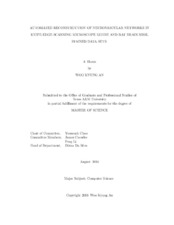| dc.description.abstract | The Knife-Edge Scanning Microscope (KESM), developed at the Brain Network
Laboratory at Texas A&M University, can image a whole small animal brain at sub-
micrometer resolution. Nissl data from the KESM enable us to look into vasculatures
and cell bodies at the same time. Hence, analyzing the images from KESM mouse
and rat Nissl data can help understand interactions between cerebral blood flow and its surrounding tissue. However, analysis is difficult since the image data contain
complex cellular features, as well as imaging artifacts, which make it hard to extract
the geometry of the vasculature and the cells.
In this project, we propose a novel approach to reconstructing the neurovascular networks from whole-brain mouse and partial rat Nissl data sets. The proposed method consists of (1) pre-processing, (2) thresholding, and (3) post-processing. Initially, we enhanced the raw image data in the pre-processing step. Next, we applied a dynamic global thresholding to ex-tract vessels in the thresholding step. Subsequently, in the post-processing step, we computed local properties of the connected components to remove various sources of noise and we applied artificial neural networks to extract vasculatures. Concurrently, the proposed method connected small and large discontinuities in the vascular traces.
To validate the performance of the proposed method, we compared reconstruction
results of the proposed method with an alternative method (Lim's method). The
comparison shows that the proposed method significantly outperforms (nine times
faster, and more robust to noise) Lim's method. As a consequence, the proposed
method provides a framework that can be applied to other data sets, even when
the images contain a large portion of low-contrast images across the image stacks.
We expect that the proposed method will contribute to studies investigating the
correlation between the soma of the cells and microvascular networks. | en |


